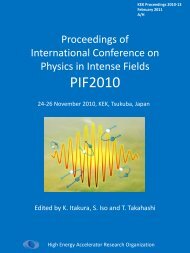TRIAC Progress Report - KEK
TRIAC Progress Report - KEK
TRIAC Progress Report - KEK
Create successful ePaper yourself
Turn your PDF publications into a flip-book with our unique Google optimized e-Paper software.
corresponds to an excited state of 22.4 MeV in 10 Be, which was also reported as a<br />
proton/triton decaying state both in the neutron capture experiment of 9 Be and in the<br />
resonant particle decay spectroscopy of 7 Li + 7 Li. It has been recently suggested that the<br />
state might be a candidate of a coexisting cluster state with cluster structures of (α+t+t)<br />
and (α+α+n+n) [3-8], which are of great importance not only for understanding the<br />
clustering phenomena in neutron rich nuclei but also for an accurate estimate of the<br />
reaction rate linked with such a state in the process of nucleosynthesis. The aim of this<br />
experiment is to determine the spin and parity of this state, by using the thick-target<br />
resonance elastic scattering of deuteron by 8 Li as shown in Fig. 3-5.<br />
Fig. 3-5. Experimental set-up and principle of the thick-target elastic scattering method for<br />
resonance-searching.<br />
Following the PAC recommendation, a feasibility test for this measurement has<br />
been performed for 3 days. A schematic figure for the experimental set-up and the<br />
measurement principle is shown in Fig. 3-5. An elastic scattering with thick target was<br />
employed in the inverse kinematics to search for the resonance states. The 8 Li beam of<br />
0.94 MeV/nucleon with an intensity of 4.5 kpps passed through a time pick-up detector<br />
(C-foil + Micro-Channel Plate (MCP) in Fig. 3-5) bombarded to the CD2 target of 2.6<br />
mg/cm 2 in thickness. The energy of the scattered particles was measured by a set of<br />
Solid State Detectors (SSD), and their time-of flight (TOF) between the MCP and SSD<br />
was also measured. As shown in Fig. 3-6, where the correlations between the energy<br />
and the TOF for detected particles were plotted, scattered deuterons were successfully<br />
identified. In the figure were also observed tritons, 8 Li particles passed through<br />
pin-holes on the target, and α-particles from decaying 8 Li, in addition to deuterons.<br />
These particles were well resolved. Based on the present result, we can conclude that<br />
the thick-target elastic scattering method for resonance-searching is feasible with the<br />
beam intensity of 8 Li presently available at <strong>TRIAC</strong> (i.e. higher than 100 kpps). For<br />
57













